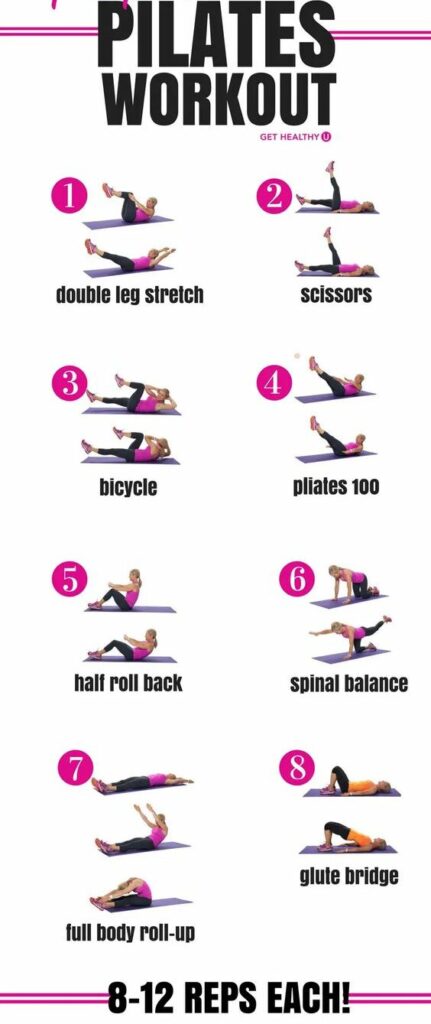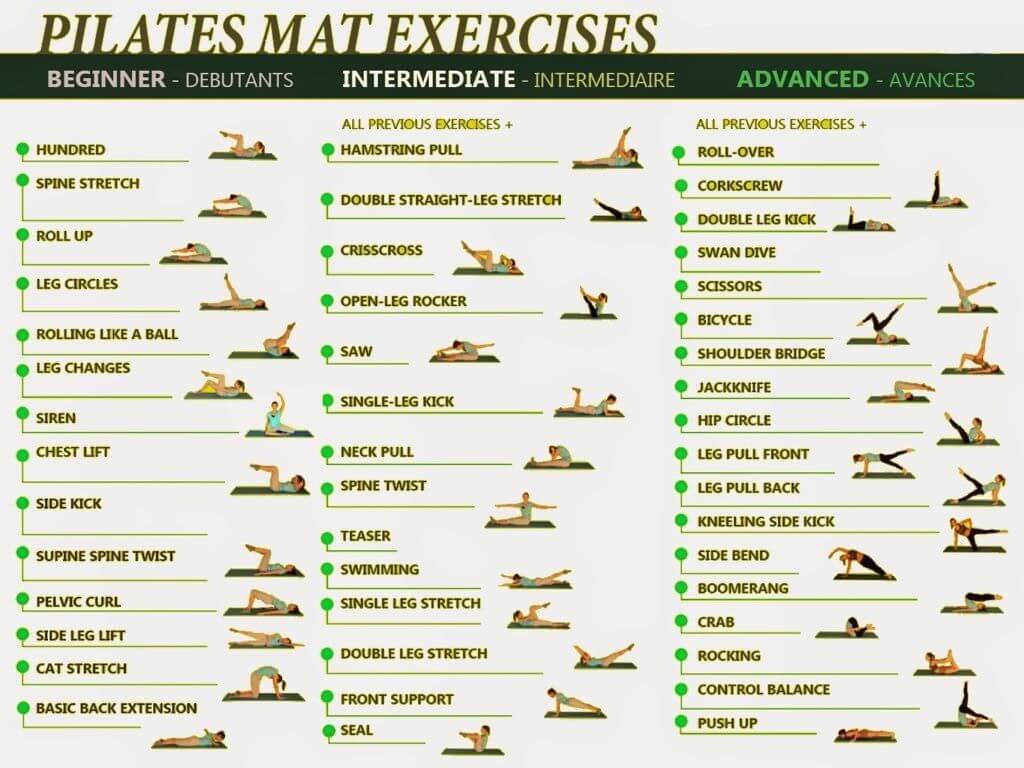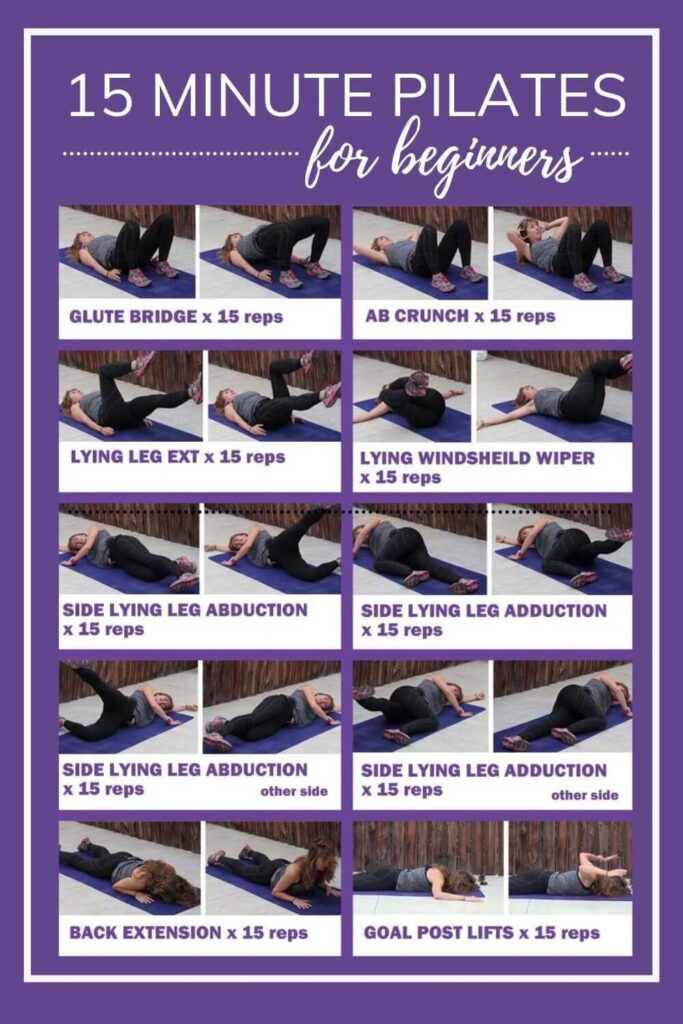


Whether you’re looking to enhance your overall fitness, increase your athletic performance, or simply enjoy a fun and effective workout, this Mat Pilates workout routine is perfect for you. So roll out your mat, connect with your breath, and let’s get started on this transformative journey towards a stronger, more balanced you!
Key Takeaways
- Mat Pilates Workout is a form of exercise that focuses on core strength and engages multiple muscle groups.
- The benefits of practicing Pilates Mat exercises include increased core stability, improved flexibility, enhanced posture, and the development of long, lean muscles.
- Regular practice of Mat Pilates workouts can contribute to weight loss and improved body composition by increasing metabolism and energy expenditure.
- Mat Pilates exercises promote mind-body coordination and mental concentration, fostering a deeper connection between physical movements and mental awareness.
- Pilates Mat offers a holistic approach to wellness, encompassing physical fitness, core strength, mental clarity, and spiritual connection.
What is Mat Pilates Workout?
Mat Pilates is an exercise that focuses on your core muscles while also training your back, arms, shoulders, abs, butt, and legs. It can be done flat on the floor. You may also try reformer pilates, which is another pilates exercise using a reformer machine.
In a mat Pilates workout, the individual uses their own body weight as the primary source of resistance. The exercises typically involve controlled and precise movements of the pelvic floor that target the core muscles, including the abdominals, back, hips, and glutes. However, mat Pilates also engages and strengthens the entire body, including the arms, legs, abs, chest, and shoulders.
Benefits of Mat Pilates Exercises
Mat Pilates offers a multitude of benefits to individuals of all fitness levels. Through a series of controlled movements and mindful breathing techniques, Mat Pilates serves as a holistic approach to wellness, targeting various aspects of physical and mental health.
- Burn fat and calories: One significant advantage of practicing Mat Pilates is its ability to facilitate fat and calorie burning. By engaging in these dynamic exercises, individuals can increase their energy expenditure, leading to weight loss and improved body over time.
- Toning that makes you look taller: Mat Pilates is renowned for its toning effects, particularly in enhancing muscle strength and improving posture. As muscles become toned and elongated through regular practice, individuals may experience a more upright and refined stature, giving the illusion of increased height.
- Get flexibility: Mat Pilates promotes enhanced flexibility by emphasizing stretches and movements that target key muscle groups. This increased flexibility not only aids in preventing injuries but also contributes to improved range of motion and overall mobility.
- Strengthen immunity: the practice of Mat Pilates has been associated with potential immunity-boosting effects. While Pilates itself may not directly strengthen the immune system, the overall improvement in physical health and well-being can contribute to a stronger immune response and better resilience against illnesses.
- Coordinate your body and mind: Mat Pilates encourages the coordination of body and mind, fostering a deep connection between physical movements and mental concentration. By focusing on alignment, breath control, and mindful awareness during each exercise, individuals can enhance their proprioception and balance.
In essence, Mat Pilates offers a comprehensive approach to wellness, encompassing physical fitness core strength, mental clarity, and spiritual connection. By incorporating this practice into one’s routine, you can reap a myriad of benefits that extend beyond the confines of the mat, leading to a healthier and more vibrant lifestyle.
Intermediate Mat Pilates Workout plan
The intermediate Pilates moves in this section require experience. Here are two intermediate Mat Pilates workout plans that you can try:
Intermediate Mat Pilates Workout Plan 1

Warm-up:
- Begin with deep breathing and engage your core muscles.
Double Leg Stretch:
- Lie on your back, and bring both knees into your chest.
- Inhale as you extend your arms and legs away from your body.
- Exhale as you circle your arms back and hug your knees back into your chest.
- Repeat for 8-10 repetitions.
Scissors:
- Lie on your back, and lift both legs to the ceiling.
- Lower one leg towards the floor while keeping the other leg lifted.
- Switch legs in a scissor-like motion.
- Repeat for 10-12 repetitions on each side.
Bicycle:
- Same starting position as Scissors.
- Mimic riding a bicycle by bending and straightening your legs in a cycling motion.
- Engage your core throughout the movement.
- Repeat for 10-12 repetitions on each side.
Pilates 100:
- Lie on your back and lift your legs to a tabletop position.
- Lift your head, neck, and shoulders off the mat.
- Pump your arms up and down while breathing in for 5 counts and out for 5 counts.
- Repeat for a total of 100 arm pumps.
Half Roll Back:
- Sit on the mat with knees bent and feet flat.
- Slowly roll back halfway, engaging your core.
- Return to the starting position with control.
- Repeat for 8-10 repetitions.
Spinal Balance:
- Come to a tabletop position on your hands and knees.
- Extend one arm forward and the opposite leg back, maintaining a neutral spine.
- Hold for a few breaths, then switch sides.
- Repeat for 8-10 repetitions on each side.
Full Body Roll-Up:
- Lie on your back with arms extended overhead.
- Slowly roll up to a seated position one vertebra at a time.
- Reach for your toes, then roll back down with control.
- Repeat for 8-10 repetitions.
Glute Bridge:
- Lie on your back with knees bent and feet hip-width apart.
- Lift your hips towards the ceiling, squeezing your glutes at the top.
- Lower back down with control.
- Repeat for 10-12 repetitions.
Remember to maintain proper form, engage your arms and core throughout the pilates exercises, and listen to your body. It’s essential to breathe deeply and stay focused on each movement to get the most out of your Pilates workout.
Intermediate Mat Pilates Workout Plan 2

Warm-up:
- Begin with deep breathing and engage your core muscles.
Hamstring Pull:
- Lie on your back, extend one leg straight up to the ceiling.
- Hold the back of your thigh with both hands.
- Extend the other leg straight along the mat.
- Gently pull the extended leg towards you.
- Hold for a few breaths, then switch legs.
- Repeat for 8-10 repetitions on each side.
Double Straight-Leg Stretch:
- Lie on your back and extend both legs to the ceiling.
- Lift your head, neck, and shoulders off the mat.
- Lower both legs towards the mat without arching your back.
- Lift your legs back up to the starting position.
- Repeat for 8-10 repetitions.
Crisscross:
- Lie on your back with knees bent and hands behind your head.
- Twist your torso, bringing one elbow towards the opposite knee.
- Switch sides in a bicycle-like motion.
- Keep your shoulder blades off the mat throughout the exercise.
- Repeat for 16-20 repetitions.
Open-Leg Rocker:
- Sit on the mat with legs extended in a straddle position.
- Balance on your sit bones and hold the outside of your ankles.
- Rock back onto your shoulders and then return to the balance position.
- Repeat for 6-8 rockers.
Saw:
- Sit tall with legs extended wider than your hips.
- Twist your torso to one side and reach towards your little toe.
- Pulse twice, then return to the center and twist to the other side.
- Repeat for 6-8 repetitions on each side.
Single-Leg Kick:
- Lie on your stomach with your chin resting on the mat.
- Bend one knee and kick your heel towards your glutes.
- Switch legs in a rhythmic kicking motion.
- Keep your core engaged and back muscles active.
- Repeat for 16-20 repetitions on each leg.
Neck Pull:
- Sit tall with your legs extended and slightly apart.
- Interlace your fingers behind your head and round your spine.
- Curl down towards your toes, engaging your abdominals.
- Roll back up with control.
- Repeat for 6-8 repetitions.
Swimming:
- Lie on your stomach with arms and legs extended off the mat.
- Flutter your arms and legs in a swimming motion.
- Keep your head and chest lifted off the mat.
- Continue for 30-60 seconds.
Single Leg Stretch:
- Lie on your back, and hug one knee into your chest while extending the other leg out.
- Switch legs in a scissor-like motion.
- Keep your head and shoulders lifted off the mat.
- Repeat for 16-20 repetitions.
Double Leg Stretch (Already included in the workout plan 1):
Refer to the description provided in Workout Plan 1.
Seal:
- Sit on the mat with your knees bent and hands holding your feet from the inside.
- Round your spine and balance on your sit bones.
- Rock back and return to the balanced position, clapping your feet together three times.
- Repeat for 6-8 reps.
Remember to focus on proper form, controlled left knee and movement, and breathing throughout each exercise. Modify as needed and listen to your body to ensure a challenging yet safe Pilates workout.
Beginner Mat Pilates Workout Plan

We not only provide the intermediate mat Pilates workout plan but also offer a complete 15-minute Pilates workout for beginners. Remember to repeat each movement 15 times and rest for 3-5 seconds between movements:
Ab Crunch:
- Lie on your back with knees bent and feet flat on the mat (keeping leg bent).
- Place your hands behind your head, elbows wide.
- Curl your upper body towards your knees, engaging your abdominals.
- Lower back down to the starting position.
- Repeat for 15 repetitions.
Lying Windshield Wiper:
- Lie on your back with your legs extended vertically towards the ceiling.
- Keep your arms out to the sides for stability.
- Lower both legs to one side, without touching the mat, and then return to the vertical position.
- Repeat on the other side.
- Alternate sides for a total of 15 repetitions.
Side Lying Leg Adduction (left leg):
- Start in the same position as the side-lying leg abduction.
- This time, lift your bottom leg towards the ceiling, crossing it over your top leg.
- Lower the leg back down without touching the top leg.
- Repeat for 15 repetitions on the left side.
Side Lying Leg Adduction (right leg):
- Start in the same position as the side-lying leg abduction.
- This time, lift your bottom leg towards the ceiling, crossing it over your top leg.
- Lower the leg back down without touching the top leg.
- Repeat for 15 repetitions on the right side.
Modify as needed and gradually begin to increase the repetitions and intensity as you begin to progress toward the ceiling.
If you like these workouts, you may also like: Wall Pilates Workout
Differences between Pilates and yoga
Pilates and yoga are both popular forms of mind-body exercise that focus on improving strength, flexibility, and overall well-being. While they share some similarities, there are also key differences between the two practices:
Core Strength
Pilates is known for its emphasis on strengthening the core muscles, including the abdominals, obliques, and lower back muscles. Many Pilates exercises target the deep stabilizing muscles of the spine, shoulder, and core, promoting better posture and spinal alignment. While yoga also strengthens the spine and core, it may not do so as directly or comprehensively as Pilates.
Movement vs. Static Poses
In yoga, practitioners often hold static poses for some time, focusing on alignment, breath, and relaxation in each posture. Pilates, on the other hand, involves more dynamic movement, with a focus on flowing sequences of exercises that target specific muscle groups and improve overall body awareness.
Equipment
While both Pilates and yoga can be practiced on a mat, Pilates also incorporates the use of specialized equipment such as reformers and stability balls to add resistance and challenge to exercises. Yoga generally does not require any equipment beyond a mat and props like blocks or straps.
Conclusion
Mat Pilates workouts are an effective form of exercise that can be tailored to different fitness levels and goals. By incorporating Mat Pilates exercises into your routine, you can improve your overall fitness, enhance core stability, promote flexibility, and cultivate a stronger mind-body connection. With Pilates, there will be a significant change between before and after three months. You’ll look better, feel better, and be healthier as a result. You might drop a little weight and start to notice your great, lean muscles. Also, your posture will improve.
Is Pilates good for weight loss?
Pilates before and after in 3 months: expect the results?
Pilates body vs gym body: what's the difference?
Difference between Mat Pilates and Yoga?
Amanda Altman. (2018). Available at: https://www.pilatesanytime.com/blog/mat/mat-sequences-for-every-level
Mat Sequences for Every Level. https://www.pilatesanytime.com/blog/mat/mat-sequences-for-every-level [Accessed 25 Mar 2024].
Marguerite Ogle MS, RYT. (2020). Advanced Pilates Exercises on the Mat. Available at: https://www.verywellfit.com/advanced-pilates-exercises-on-the-mat-2704716 [Accessed 25 Mar 2024].
Pilates encyclopedia. (2021). What are Beginner, Intermediate, and Advanced Exercises in Pilates? Available at: https://www.pilatesencyclopedia.com/blog/beginner-intermediate-advanced [Accessed 25 Mar 2024].





